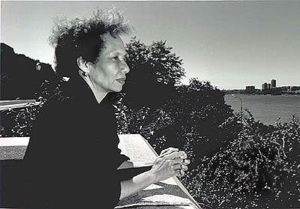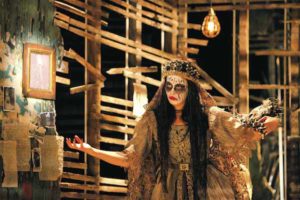A THINK TWICE DRAMA worth the wait:
HE BROUGHT HER HEART BACK IN A BOX
The sad, aching thing about Adrienne Kennedy’s new play set in the Jim Crow South of 1941 is how relevant it is today to our divided nation. This disturbing and haunted one act–produced by Theatre for a New Audience–is the world premiere of the first new Adrienne Kennedy play in almost a decade.
HE BROUGHT HER HEART BACK IN A BOX is a two-character dramatic recital as cerebral and deep as anything you may experience on the stage. Under the often sweet surface, HEART simmers with rage against the violence of segregation and abuse of power in wartime Montefiore, Georgia. And well beyond.
Adrienne Kennedy’s new play is a surreal ride on a segregated train. The train travels through a landscape of memories made up of songs and school plays, old photographs, walks through a Georgia peach orchard, and a murdered body at the bottom of an elevator shaft in Cincinnati.
The simple and effective staging of HEART utilizes a life-size marionette and symbolic ascending and descending stairs. With the direction of Evan Yionoulis, featured performers Julianna Canfield and Tom Pecinka convey admirably the play’s complex atmosphere.
Since her first play, 1964’s Funnyhouse of a Negro, Kennedy has produced a range of wild, mesmerizing experimental plays that defy traditional expectations for the stage. Werner Sollors comments in the introduction to The Adrienne Kennedy Reader:
Exploring the violence racism visits upon people’s lives, Kennedy’s plays express poetic alienation, transcending the particulars of character and plot through ritualistic repetition and radical structural experimentation. Frequently produced, read, and taught, they continue to hold a significant place among the most exciting dramas of the past fifty years.
HEART’S two seventeen-year-old narrators Kay and Chris (played by Canfield and Pecinka) recite the bittersweet poem of knowing each other all of their lives in Montefiore.
Montefiore, Georgia has a population of six hundred who are all “somehow connected.”
Chris is the son of landowner and businessman Harrison Aherne, key architect and enforcer of the town’s segregation. Kay lives with her grandmother in the center of the colored district. Her white father, Charles Felton, is a mystery author and close friend of Chris’s father. Her “colored” mother Mary shot herself in the head–or so it was made to seem–when Kay was a baby and Mary was only fifteen.
As the story-poem begins Kay is at the top of a stairwell looking through to a stage where there is a school play in progress. Christopher Marlowe’s tragedy Paris Massacre. This sixteenth-century tragedy is being performed by adolescent children of the colored boarding school. It was poorly chosen (and that’s the point) by the school’s founder, Chris’s father Harrison.
Chris ascends the stairs from the storeroom where he has been balancing the school books for his father. He and Kay observe the Paris Massacre performance, making note of Harrison’s “Nigra children, the three on the end.” It is common knowledge that Harrison is their father, though, as Kay remarks, he never walks on the grounds with them.
Chris goes on to reveal, rather chillingly, that his father built the Aherne Garden Cemetery for the mothers of his colored children. “They are the only Nigra women in Montefiore to have tombstones on their graves,” he says. His own mother Pearl has been buried that very day. And Pearl used to tell him that his father loved his colored children more than he loved them. Acrimonious to the end, Pearl has seen to it that her husband Harrison’s illegitimate children won’t inherit anything.
Here is the suggestion of the theme that will run throughout HE BROUGHT HER HEART BACK IN A BOX: the cold pretense of social order and decency being preserved and the underlying reality of privileged racist insanity–and the hypocrisy of inter-racial sex from community leaders who demand strict social borders in all other aspects of small-town life.
The narrators reminisce seeing each other while Chris walked through the family peach orchards with his father and Kay was resting under a willow tree. Chris tells Kay that he is leaving for New York for a career on the stage. He wants Kay to join him there later and they will be married. But Kay has trepidations regarding their elopement.
Kay recalls her own mother Mary leaving home, arriving in Cincinnati just five days after she was born. Her mother intended to marry Robert, a man from Monefiore working as a handyman in Cincinnati. Mary had left Kay with relatives. Kay tells us that in less than three weeks her mother was found stabbed to death at the bottom of an elevator shaft–this the truth beneath the lie that she had committed suicide.
There is the sense of doom created by the violent school play Paris Tragedy and Kay’s memory of her mother’s murder. Kay believes that her and Chris’s fathers can do whatever they please and get away with it. Yet the young lovers dream of being married and then living in Paris after the war. Their lives will play out–at least in their dreams–like the Noel Coward operetta and romance movie Bitter Sweet.
Adrienne Kennedy, as Susan Lori Parks has said, is one of the greats of contemporary playwriting. In her BOMB Magazine interview, S. L .P. offers up what playwrights experience from reading Kennedy’s work.
A person who’s new to theater can read your work and think: I can do anything I want. That’s what your plays did for me. I can do with theater what I think needs to be done–it’s liberating.
I, too, remember that liberating feeling from my first introduction to Adrienne Kennedy’s plays. It made me wanted to test out ideas I previously thought were fool’s gold. New York Times critic Clive Barnes observed in 1969 that while almost every black playwright was concerned with realism, “Miss Kennedy is weaving some kind of dramatic fabric of poetry.”
Besides Funnyhouse of a Negro, other notable plays by Kennedy are The Owl Answers (1965), A Rat’s Mass (1967), A Lesson in Dead Language (1968), Sun (1969), A Movie Star Has to Star in Black and White (1976) , Diary of Lights (1987), The Ohio State Murders (1992, produced by TFANA in 2007), Motherhood 2000 (1994), June and Jean in Concert (1995).
With her latest work HEART, Kennedy has far from mellowed. The conflict is much grander than can be expressed through characters bickering on the stage, the typical strategy for advancing a plot. She rejects the traditional rules of drama as if they were from the same kind of mentality that produced segregation in the South. A classical sense of dramatic elements like plot and character and the unities of time, place, and action are rejected as divisions harmful to her expression as an artist. One can even infer from her “open form” that she equates the rules of traditional drama with the rules of segregation and the signs WHITE and COLORED.
The artistry of HE BROUGHT HER HEART BACK IN A BOX starts with the title, a gruesome and mysterious statement indicative of how this play will unfold. Much of the key information of this tragedy comes through in retold testimonals, from the whispered words of characters as relayed by other characters and then told to the audience by Kay or Chris in their duet of monologues. As in her other work, Kennedy defies a contemporary system of poetics in favor of a play drawn from deep inside her.
About her creative process she wrote in 1987:
Without exception the days when I am writing are days of images fiercely pounding in my head and days of walking . . . in Ghana across the campus of Legon, in Rome through the Forum, in New York along Columbus Avenue,and in London, Primrose Hill (hadn’t Karl Marx walked there?). Walks and coffee, all which seem to put me under a spell of sorts . . . . I am at the typewriter almost every waking moment and suddenly there is a play. It would be impossible to say I wrote them. Somehow under this spell they become written.
If you are not familiar with Adrienne Kennedy’s work–or if you want to reacquaint yourself with one of America’s greatest playwrights–this production of HEART presents an excellent opportunity. So relevant to our still divided nation, HE BROUGHT HER HEART BACK IN A BOX will be playing through February 11th at the Polonsky Shakespeare Center in Brooklyn.



Leave a Reply